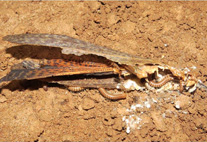Abstract
Ektaphelenchoides fuchsi n. sp., recovered from a soil sample around the rhizosphere of Cucurbita maxima in western Iran, is described and illustrated based on morphological and molecular characters. The new species is characterized by its body length of 529–712 µm, continuous lip region, lateral fields with three incisures, total stylet length of 14–18 µm with rounded basal knobs, excretory pore 70–84 µm and hemizonid 87–96 µm from the anterior end, post-uterine sac short, 6–9 µm long in female and tail conoid with long filiform terminus in male. Based on morphological and molecular characters, the new species is close to E. kelardashtensis, E. attenuata, and E. musae. It differs from the closest species E. kelardashtensis by its longer sylet (14–18 vs 13–16 µm) and stylet with basal knobs vs not, longer post uterine sac (6–9 vs 3–6 µm), more posterior position of excretory pore and hemizonid (70–84 vs 55–66 and 87–96 vs 67–78 µm, respectively), and longer spicules (12–13 vs 8–10 µm). Comparisons with other species of Ektaphelenchoides are also discussed. Molecular analyses were performed based on 631 bp of the partial ribosomal RNA large subunit gene (D2/D3 of LSU) and showed that E. fuchsi n. sp. is unique when compared with other species of the genus for which sequences of that region are available.

